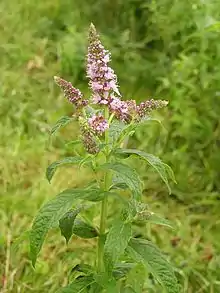Mentha longifolia
Mentha longifolia (also known as horse mint,[1] brookmint,[2] fillymint or St. John's horsemint; syn. M. spicata var. longifolia L., M. sylvestris L., M. tomentosa D'Urv, M. incana Willd.) is a species in the genus Mentha (mint) native to Europe excluding Britain and Ireland,[3] western and central Asia (east to Nepal and the far west of China), and northern and southern (but not tropical) Africa.[4][5][6]
| Mentha longifolia | |
|---|---|
 | |
| Scientific classification | |
| Kingdom: | Plantae |
| Clade: | Tracheophytes |
| Clade: | Angiosperms |
| Clade: | Eudicots |
| Clade: | Asterids |
| Order: | Lamiales |
| Family: | Lamiaceae |
| Genus: | Mentha |
| Species: | M. longifolia |
| Binomial name | |
| Mentha longifolia | |
Description
It is a very variable herbaceous perennial plant with a peppermint-scented aroma. Like many mints, it has a creeping rhizome, with erect to creeping stems 40–120 cm tall. The leaves are oblong-elliptical to lanceolate, 5–10 cm long and 1.5–3 cm broad, thinly to densely tomentose, green to greyish-green above and white below. The flowers are 3–5 mm long, lilac, purplish, or white, produced in dense clusters (verticillasters) on tall, branched, tapering spikes; flowering in mid to late summer. It spreads via rhizomes to form clonal colonies.[6][7][8]
Taxonomy
Subspecies
There are seven subspecies:[4][5][8]
- Mentha longifolia subsp. longifolia, Europe, northwest Africa
- Mentha longifolia subsp. capensis (Thunb.) Briq., southern Africa
- Mentha longifolia subsp. grisella (Briq.) Briq., southeastern Europe
- Mentha longifolia subsp. noeana (Briq.) Briq., Turkey east to Iran
- Mentha longifolia subsp. polyadena (Briq.) Briq., southern Africa
- Mentha longifolia subsp. typhoides (Briq.) Harley., northeast Africa, southwest Asia
- Mentha longifolia subsp. wissii (Launert) Codd., southwestern Africa
It has been widely confused with tomentose variant plants of Mentha spicata; it can be distinguished from these by the hairs being simple unbranched, in contrast to the branched hairs of M. spicata.[7]
Hybrids
Mentha longifolia hybridizes with other Mentha species. Hybrids include:
- Mentha × villosa-nervata Opiz. (hybrid with Mentha spicata) sharp toothed mint
- Mentha × rotundifolia (L.) Huds., 1782 (hybrid with Mentha suaveolens) false apple mint
Cultivation
Like almost all mints, Mentha longifolia can be invasive. Care needs to be taken when planting it in non-controlled areas.
Uses
Nicholas Culpeper's Complete Herbal (1653) states that "It is good for wind and colic in the stomach ... The juice, laid on warm, helps the King's evil or kernels in the throat ... The decoction or distilled water helps a stinking breath, proceeding from corruption of the teeth, and snuffed up the nose, purges the head. It helps the scurf or dandruff of the head used with vinegar."[10] In addition, Mentha longifolia, like other Mentha species, is known to have important medicinal properties.[11]
References
- BSBI List 2007 (xls). Botanical Society of Britain and Ireland. Archived from the original (xls) on 2015-06-26. Retrieved 2014-10-17.
- "PlantFiles: Mentha Species, Brook Mint, Horsemint". Dave's Garden. Retrieved 2 August 2023.
- "The IUCN Red List of threatened species: Mentha longifolia (Horse Mint)". International Union for Conservation of Nature and Natural Resources. 25 April 2013. Retrieved 24 August 2018.
- Euro+Med Plantbase Project: Mentha longifolia Archived 9 March 2012 at the Wayback Machine
- African Flowering Plants Database: Mentha longifolia
- Flora of China: Mentha longifolia
- Blamey, M. & Grey-Wilson, C. (1989). Flora of Britain and Northern Europe. ISBN 0-340-40170-2
- Huxley, A., ed. (1992). New RHS Dictionary of Gardening. Macmillan ISBN 0-333-47494-5.
- Royal Horticultural Society plant finder and selector https://www.rhs.org.uk/plants/search-results?form-mode=true&query=Mentha%20longifolia
- Grieve, Maud (1971). A Modern Herbal: The Medicinal, Culinary, Cosmetic and Economic Properties, Cultivation and Folk-lore of Herbs, Grasses, Fungi, Shrubs, & Trees with All Their Modern Scientific Uses, Volume 2.
- Sevindik, Mustafa. "Determination of therapeutic potential of Mentha longifolia ssp. longifolia". Fresenius Environmental Bulletin. 26 (7): 4757–4763.